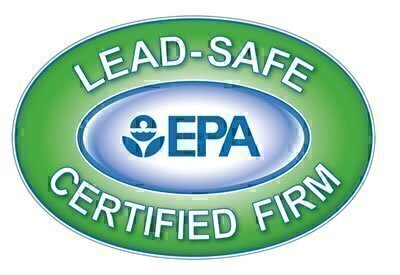Last updated June 2021
 In 1978, the federal government banned the use of lead-based paint in homes after long-term studies showed that lead causes severe health problems, especially in children under age six, damaging their nervous systems even before birth. Toddlers that chewed on cribs and window sills painted with lead-based paint had high lead blood levels, and many developed critical learning disabilities and behavioral problems. Although it’s off the market, millions of homes still contain this potential danger on the walls. As long as it’s in good condition, lead-based paint probably isn’t a hazard; but scraping and sanding changes that. Over the years it’s become clear that the dust produced by renovation work can be just as harmful as ingested paint chips.
In 1978, the federal government banned the use of lead-based paint in homes after long-term studies showed that lead causes severe health problems, especially in children under age six, damaging their nervous systems even before birth. Toddlers that chewed on cribs and window sills painted with lead-based paint had high lead blood levels, and many developed critical learning disabilities and behavioral problems. Although it’s off the market, millions of homes still contain this potential danger on the walls. As long as it’s in good condition, lead-based paint probably isn’t a hazard; but scraping and sanding changes that. Over the years it’s become clear that the dust produced by renovation work can be just as harmful as ingested paint chips.
Because of these dangers, in 2008 the U.S. Environmental Protection Agency (EPA) issued the Renovation, Repair and Painting (or “RRP”) Rule, which requires contractors working in pre-1978 homes to be Lead-Safe Certified and use special work practices to contain and clean-up dust. Companies can achieve certification by applying to the EPA (or an authorized state) and having their workers or supervisors take an eight-hour course that instructs them on specific work practices to protect the home’s residents from exposure to lead during renovation, repair, and painting projects.
 Even very small projects are covered by the law, which kicks in when more than six square feet of painted surface inside or 20 square feet outside are disturbed by the work. This means that even a small painting project or single window replacement is covered by the rule. The law also applies to landlords who renovate rental properties, but it doesn’t apply to DIYers—although you’ll obviously want to do everything you can to minimize the risks of lead-paint exposure to your kids.
Even very small projects are covered by the law, which kicks in when more than six square feet of painted surface inside or 20 square feet outside are disturbed by the work. This means that even a small painting project or single window replacement is covered by the rule. The law also applies to landlords who renovate rental properties, but it doesn’t apply to DIYers—although you’ll obviously want to do everything you can to minimize the risks of lead-paint exposure to your kids.
Most homeowners are unaware of the law, but by now all contractors should be aware of their obligations. Unfortunately, many companies still aren’t doing what they can to protect their customers. We strongly urge anyone who lives in a pre-1978 home to hire only Lead-Safe Certified contractors (look for the EPA Lead-Safe Certified logo) and demand that workers follow the law when performing work in areas where lead-based paint could be disturbed. The testing and work habits required by the law are simple enough and usually add little to project costs.
A good place to start looking for information about lead is www.epa.gov/lead. The EPA site includes a searchable database that lets you verify that prospective contractors are certified.
To evaluate the risks of lead-based paint in your home, do the following:
- Have your children tested. According to the American Academy of Pediatrics, “there is simply no safe level of lead exposure for children.” All children should be screened for lead at ages one and two. For more information, check the Centers for Disease Control and Prevention pamphlet “What Do Parents Need to Know to Protect Their Children?” and other information available at www.cdc.gov/nceh/lead.
- If a blood test indicates your child has been exposed to lead, get a lead-certified professional to check your home for lead. A lead-paint inspection performed by a certified contractor tells you only about the lead content of painted surfaces—not if they are a hazard or how to deal with them. A risk assessment, conducted by a certified inspector, will indicate sources of serious lead exposure and ways to eliminate them. The risk assessment is thorough and expensive—about $500 plus around $10 to $15 per lab sample—but if your child has been exposed, you need to eliminate additional exposure.
- Check for lead before work begins. If your home was built before 1978, ask prospective contractors to show proof of their Lead-Safe certification. In any contracts you sign, include a statement saying that the contractor “will follow EPA regulations for containing the work area and minimizing the generation of lead-paint dust.” Also have companies detail any extra fees that will be imposed if they have to employ lead-safe work practices.
 The tasks a contractor—and you, if you’re doing the work—should do to minimize lead exposure depend on the type of work being done, but in general the following steps should be taken:
The tasks a contractor—and you, if you’re doing the work—should do to minimize lead exposure depend on the type of work being done, but in general the following steps should be taken:
- If children or women who could possibly be pregnant live in the home, they should stay out of the work area until work and cleanup is complete.
- Identify in advance any surfaces that might contain lead-based paint that might be disturbed while work is performed. Unless absolutely necessary, don’t disturb these surfaces by sanding, scraping, or cutting.
- If possible, take materials containing lead-based paint outside to work on. For example, if a door must be stripped of old paint, do it outdoors.
- For large jobs, seal off rooms where work is performed from the rest of the home using two layers of six-mil plastic sheeting. Also, seal the ducts in these rooms. Post signs warning of possible lead exposure risks in these areas. And lay plastic sheeting on the floor to ease cleanup. If possible, perform work in just one room at a time.
- Remove all furnishings in the work area; if removal is not possible, cover and seal the furnishings underneath two layers of six-mil sheeting.
- Workers should wear protective clothing, including approved respirators.
- Carefully contain, and properly dispose of, all waste generated during the work.
- Power tools used to sand or sand-blast should be equipped with shrouds and HEPA-filtered vacuum attachments. Never use open flames to treat surfaces.
- After completion of work, thoroughly clean all surfaces, including vacuuming with a HEPA-filtered device.
- After cleanup, contractors must test to determine if cleanup was adequate; if not, the area should be cleaned again.
As you can see, it takes extra effort to follow the law. But don’t assume this extra work comes at a steep price—and don’t allow companies to use the threat of sky-high prices to persuade you to allow them to skimp on the rules. We spoke with various owners of top-rated painting businesses; most routinely don’t charge more when they have to follow the lead-safe law, and those that do charge more assess only a $100 to $200 fee for large jobs. Window installation companies we spoke with charge between $0 and $75 more per window when they have to follow the EPA’s work rules. Such a surcharge seems a small price to pay to eliminate a potential health hazard to your kids.

